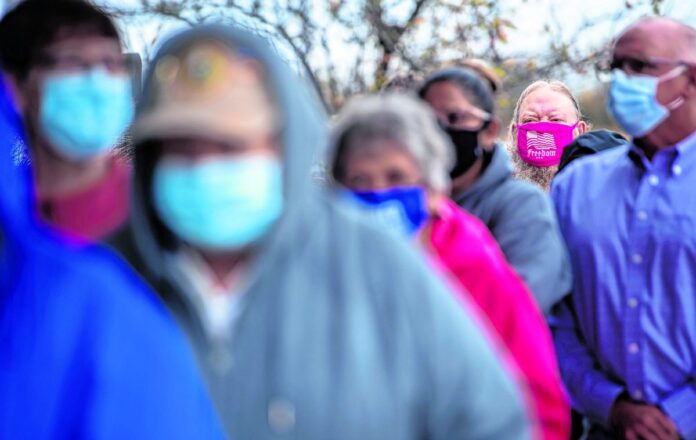
“COVID Fatigue” is a real thing. I have it. You likely have it, too. While I have become accustomed to wearing a mask, I still don’t like it. The constant washing of hands was fine in the summer, but now that the air is drying out, so is my skin. And, though I am an introvert by nature, I find myself missing crowds. I am so over COVID! Unfortunately, COVID is not over me.
On Wednesday, Oct. 21, the state recorded 2,842 COVID cases in a single day. As of Monday, Oct. 26, the state had recorded more than 2,000 cases a day for seven of the previous 11 days. At the “height” of the pandemic in April and May, the highest day was 946. This more than doubling of cases is understandably concerning to many people. After all, why did we shut down the country in April, but we don’t seem to be considering it today? Why are the case levels so much higher? When will this all be over?
In May in Indiana, we were testing fewer than 8,000 people per day. Now we are averaging 25,000, with some days in excess of 35,000. This tripling of testing volumes is because tests are readily available to virtually anyone, for any reason. Hancock Health and the Hancock County Health Department have partnered to offer two free state-supported testing sites at Immediate Care locations in Greenfield (on Muskegon Road), and at the Gateway campus ( Interstate 70 and Mt. Comfort Road). In the spring, only people with symptoms could be tested; thus the positivity rate was very high (20%+). Because we test so many more people in our state now, the individual positivity rate declined to a much lower number (7%) and had been stable for several months, giving us confidence in the results. That positivity rate has been on a steady upward climb for the past 30 days, and, at 13%, is nearly double our experience over the summer.
Perhaps a better indicator of the impact of the disease is the number of people admitted to the hospital with it. After all, we shut down our society and “sheltered in place” because we thought the hospitals would be overwhelmed. In response, hospitals stopped their elective services, closed their outpatient facilities and prepared for the surge. While the number of patients with COVID in hospitals did increase dramatically, topping out at 1,500 inpatients statewide on any given day, most of us were not overrun, and we had plenty of inpatient capacity and ventilators to spare. Over the summer, the number of COVID patients in the hospital declined to half that number and remained there for several months. Over the past few weeks, COVID inpatient census in Indiana hospitals has returned to more than 1,500.
[sc:text-divider text-divider-title=”Story continues below gallery” ]
I believe the best indicator for the impact of the disease is mortality. In May, the number of daily deaths due to COVID neared 40 per day statewide. Over the summer, this declined to fewer than 10 per day. The average for the past several days has been near 30. One might say that these figures are overstated, and that people died “with” COVID rather than “from” COVID. Let me ask, though: If a person receives a terminal cancer diagnosis from their doctor and is given weeks to live, then a few days later is run over by a bus and dies, what killed them? They died “with” cancer; they died “from” the bus accident. COVID in this case is the bus…
All the data — cases, hospitalizations, deaths — point to a serious situation, worse in many ways than what we experienced at the “height” of the pandemic, so why are we not taking it more seriously? Why are we not sheltering in place again? It’s because the virus itself has changed; we have been more careful as a society; and we have learned much about this disease in the intervening months. The coronavirus appears to be more infectious, but less lethal. Wearing masks, washing hands and avoiding crowds has worked. We have developed approaches to treating the disease that are better, and exceptional treatments are just coming into use. A vaccine is on the way and has the potential to return us to “normal” life. That’s the good news.
The bad news is that the vaccine will not be fully distributed until mid-2021 at the earliest. The bad news is that the new, exceptional, treatments are just now being approved and may not make it to all our hospitals for several months. The bad news is that wearing masks, washing hands, and avoiding crowds only work if we actually do them.
The decisions we make now will have a huge impact on the experience we have this winter. We can succumb to “COVID Fatigue” and go back to life as usual. The disease may spread to many more of us, and frankly, most of us will be fine. But some of us — the elderly, those with chronic health conditions, and the unexpected healthy person — will not. Deaths will climb dramatically, hospitals will fill up and there will be clamors for sheltering in place to happen again. Our community, our state, our country, cannot afford to hunker down again. It will take years to recover from the first shutdown; I can’t imagine the impact of another one.
So, what do we do? It’s simple, really. Practice common courtesy and common sense. Wear your mask, wash your hands, keep your distance, get your flu shot. Be cautious but not anxious. The light at the end of the tunnel is there regardless of what we do, but the path we take in getting there is entirely up to us.
Steve Long is president and CEO of Hancock Health and Hancock Regional Hospital.



